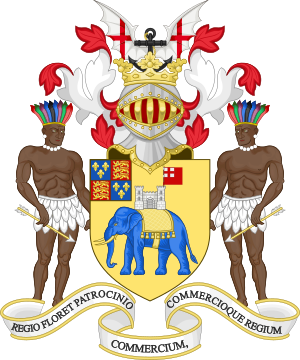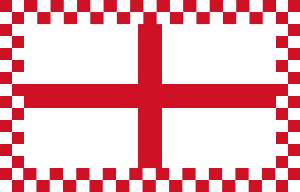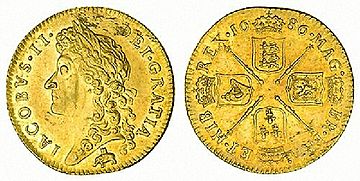Royal African Company facts for kids

Coat of arms
|
|

Company flag (c. 1665)
|
|
|
Formerly
|
Company of Royal Adventurers Trading to Africa |
|---|---|
| Private | |
| Industry | Mercantile trading |
| Founded | 1660 in London, England |
| Founders | House of Stuart City of London merchants |
| Defunct | 1752 |
|
Key people
|
James II, Charles II |
| Products | Gold, silver, ivory, humans |
The Royal African Company (RAC) was an English trading company. It was started in 1660 by the House of Stuart (the royal family) and merchants from London. Their goal was to trade along the West African coast.
James, Duke of York, who was the brother of Charles II of England, oversaw the company. King Charles II gave the RAC a special right called a monopoly. This meant only the RAC could trade with Africa for England.
At first, the company wanted to find gold in the Gambia River area. But soon, the RAC started trading in enslaved people. This became their biggest business. Historians believe the RAC sent more enslaved Africans to the Americas than any other company during the Atlantic slave trade. The RAC also traded in other goods like ivory, mostly from the Gold Coast.
In 1697, William III of England ended the company's monopoly. This happened because the Parliament of England put pressure on him. The RAC then struggled financially and officially closed in 1752. Its remaining assets went to a new group called the African Company of Merchants.
Contents
History of the Royal African Company
Early Trading in Africa
In the 1600s, European settlements in West Africa were mainly for trading. They focused on gold, ivory, and especially on getting enslaved people for the West Indies and the Americas. Europeans lived in strong trading posts called factories. But they did not rule the land or the local people.
Local tribes helped by trading between the Europeans and slave hunters from inland. European countries often competed fiercely. The Dutch, for example, used local allies against their rivals. Before the Stuart Restoration (when King Charles II returned to power), the Dutch were the main suppliers of enslaved people to English plantations. But England wanted to take over this profitable trade.
Company of Royal Adventurers

The company was first called the Company of Royal Adventurers Trading into Africa. In 1660, it received a special document called a charter. This charter gave it the sole right to English trade along the west coast of Africa. Its main goal was to find gold.
In 1663, a new charter was given. This one also included the trade in enslaved people. This company was the third English group to focus on Africa. It took over only one important trading post from the East India Company. This post was Cormantin, near a Dutch station in what is now Ghana. The 1663 charter stopped others from trading in "redwood, elephants' teeth, negroes, slaves, hides, wax, guinea grains, or other commodities."
In 1663, Captain Holmes captured or destroyed Dutch settlements on the coast. In 1664, Fort James was built on an island in the Gambia river. It became a new center for English trade. However, this led to many battles where forts were captured and recaptured. In 1667, the Treaty of Breda confirmed that Cape Coast Castle belonged to the English.
These forts were used as trading spots. The company could also seize any English ships that tried to trade without permission. The King and the company would split the money from these seized ships.
The company faced financial problems in 1667 during the Second Anglo-Dutch War. For a few years, it continued some trade, but it struggled.
The Royal African Company of England
The original African Company lost too much money and gave up its charter in 1672. A new, more ambitious company was then formed: the Royal African Company of England. Its new charter was much broader. It allowed the company to build forts, set up trading posts, have its own soldiers, and use martial law (military rule) in West Africa. This was all to help them trade in gold, silver, and enslaved Africans.
Until 1687, the company was very successful. It built six forts on the Gold Coast. It also set up another post at Ouidah, which became its main center for trading enslaved people. Cape Coast Castle was made stronger and became very important.
The Slave Trade
In the 1680s, the company transported about 5,000 enslaved people each year. Most were sent to markets in the Caribbean. Many enslaved people were branded with the letters "DoY" on their skin. This stood for the Duke of York, who was the company's governor and later became King James II. Other enslaved people were branded with the company's initials, RAC, on their chests.
Historian William Pettigrew said that the Royal African Company "shipped more enslaved African women, men and children to the Americas than any other single institution during the entire period of the transatlantic slave trade." He also noted that the company's investors knew exactly what was happening and wanted to profit from it.
Between 1672 and 1731, the Royal African Company sent 187,697 enslaved people on its own ships to English colonies in the Americas. Sadly, 38,497 of them died during the journey. The earlier company, the "Company of Royal Adventurers" (1662-1672), transported 26,925 enslaved people. Of those, 6,620 died during the trip.
Later Years and End of the Company
From 1694 to 1700, the company was involved in the Komenda Wars in Komenda, Ghana. The company worked with a local merchant and other African kingdoms. They tried to set up a permanent fort and trading post in Komenda. The company faced many losses during wars with the French.
In 1689, the company lost its special monopoly. This happened after the Glorious Revolution changed royal power in England. To keep the company going, Parliament passed a law in 1697 called the Trade with Africa Act 1697. This law allowed all English merchants to trade with Africa. However, they had to pay a ten percent fee to the Royal African Company on all goods they sent out of Africa.
The company could not compete under these new rules. By 1708, it was in financial trouble. It continued with much less activity until 1750. The company stopped transporting enslaved people in 1731. After that, it focused on trading ivory and gold dust.
From 1668 to 1722, the Royal African Company supplied gold to the Royal Mint in England. Coins made with this gold often had an elephant symbol below the king or queen's image. This gold also gave the coin its name, the guinea.
Important People in the Company
The company's rules stated it would have a Governor, Sub Governor, Deputy Governor, and 24 Assistants. The Assistants were like a modern-day board of directors.
- James Stuart, Duke of York: He was the Governor from 1660 to 1688 and the company's biggest shareholder. He later became King James II.
- Edward Colston (1636–1721): A merchant and philanthropist (someone who gives money to good causes). He owned shares in the company from 1680 to 1692. From 1689 to 1690, he was the Deputy Governor, a very important role.
- Charles Hayes (1678–1760): A mathematician, he was the sub-governor in 1752 when the company closed.
- Malachy Postlethwayt: A director and supporter of the company.
Notable Investors and Officials
- Charles II of England
- Sir Edmund Andros
- Sir John Banks
- Benjamin Bathurst
- Henry Bennet, 1st Earl of Arlington
- George Villiers, 2nd Duke of Buckingham
- Sir Josiah Child
- Sir Robert Clayton
- Sir George Carteret
- Sir Peter Colleton
- Anthony Ashley Cooper, 1st Earl of Shaftesbury
- Earl of Craven
- Lawrence Du Puy
- Sir Samuel Dashwood
- Ferdinand Gorges
- Francis, Lord Hawley
- George Frideric Handel
- Sir Jeffrey Jeffreys
- Sir John Lawrence
- John Locke
- Sir John Moore
- Samuel Pepys
- James Phipps of Cape Coast Castle
- Thomas Povey
- Sir William Prichard
- Sir Gabriel Roberts
- Prince Rupert
- Tobias Rustat
- Robert Aske
- Sir John Shaw, 1st Baronet
- Sir Robert Vyner, 1st Baronet
- Matthew Wren
End of the Company
The Royal African Company was officially closed by the African Company Act 1750. Its assets were then given to the African Company of Merchants. These assets mainly included nine trading posts on the Gold Coast. These posts were called factories: Fort Anomabo, Fort James, Fort Sekondi, Fort Winneba, Fort Apollonia, Fort Tantumquery, Fort Metal Cross, Fort Komenda, and Cape Coast Castle. Cape Coast Castle was the main office.
See also
- List of trading companies

